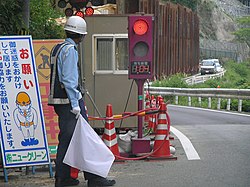Traffic guard
This article does not cite any sources. (May 2013) |
 Japanese traffic guard | |
| Occupation | |
|---|---|
| Names | Flagger, Traffic Controller |
Occupation type | Employment |
Activity sectors | Traffic, law enforcement, security, civil engineering |
| Description | |
Related jobs | Construction worker, guard, police |
A traffic guard, traffic controller, flagman, or flagger is a person who directs traffic through a construction site or other temporary traffic control zone past an area using gestures, signs or flags. The person directing traffic is responsible for maintaining the safety and efficiency of traffic, as well as the safety of road workers, while allowing construction, accident recovery or other tasks to proceed. Traffic guards are commonly used to control traffic when two way roads are reduced to one lane, and traffic must alternate. Their duties are to direct traffic to safer areas where construction or traffic incidents are taking place. In addition they have to moderate the traffic density to not cause traffic jams. They guide motorists to follow the traffic laws; but may not be able to enforce the law. Most traffic guards are seen as construction workers; but in some nations, they dress or perform as security guards and police officers.
Duties and careers[]
- Highway and expressway safety
Traffic guards are employed on highways and expressways. They are trained to set up warning signs and barricades to slow down the speed of traffic in a temporary traffic control zone. Some areas have full-time traffic guard teams for responding to incidents that could risk the safety to motorists. When they are on scene they will set up equipment to warn approaching traffic about the incident.
- Intersections
If construction or maintenance is occurring in an intersection and a law enforcement officer is not used to direct traffic, a traffic guard would control the intersection instead of the traffic light or signs.
- Road construction

Traffic guards who are directing traffic during road construction often alternate opposing traffic through a single lane. One direction of traffic is stopped at a time.
Crossings

Traffic guards who are stationed at a crossing with no signal or placed for extra safety at a junction. They stop pedestrians and vehicles from crossing a junction where another thing has the right of way to cross.
- Parking and gate guard
These traffic guards are waiting for motorists to leave and enter a complex. They also help pedestrians cross or stop them in front of the complex's entrance. They act as second pair of eyes to keep motorists and pedestrians safe. They may direct street traffic to stop for exiting motorists from the complex and they may not allow in doing that.
Equipment[]
- Signal flags; a small or large flag in colors such as white, red, and orange.
- Signal hand sign; called stop/slow paddles in the United States, these are a sign that has 'stop' on one side and 'slow' or 'go' on the other side.
- Signal baton (or marshalling wand); a baton that lights up or reflects light.
- Traffic vest; a brightly colored vest that is made to reflect headlights light or has built in LED lights.
- Helmet (or a hard hat); protecting the head from hazards.
- Signal flares; flares for night or bad weather.
- Traffic cones and warning signs, which are road traffic control devices used to slow down traffic and guide drivers.
See also[]
- Traffic warden
- Crossing guard
- Level crossing
- Gestures
- Road traffic control
- Road traffic safety
- Roadworks
- Security guard
- Traffic barrier
- Traffic cadet
- Traffic officer
- Security guards
- Crime prevention
- Road transport
- Road traffic management
- Traffic law
- Road safety
- Pedestrian crossings
